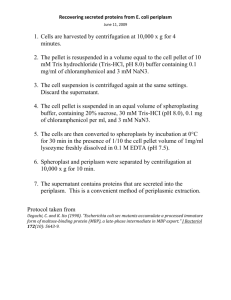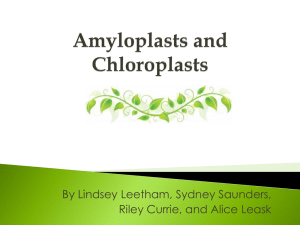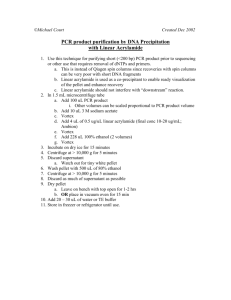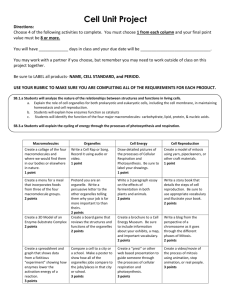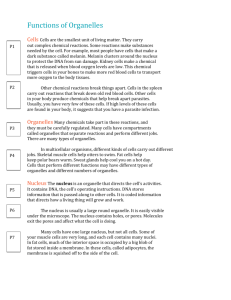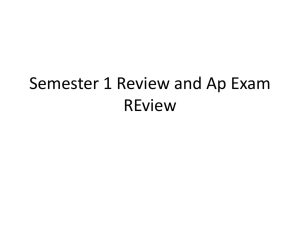Cell Fractionation Lab
advertisement
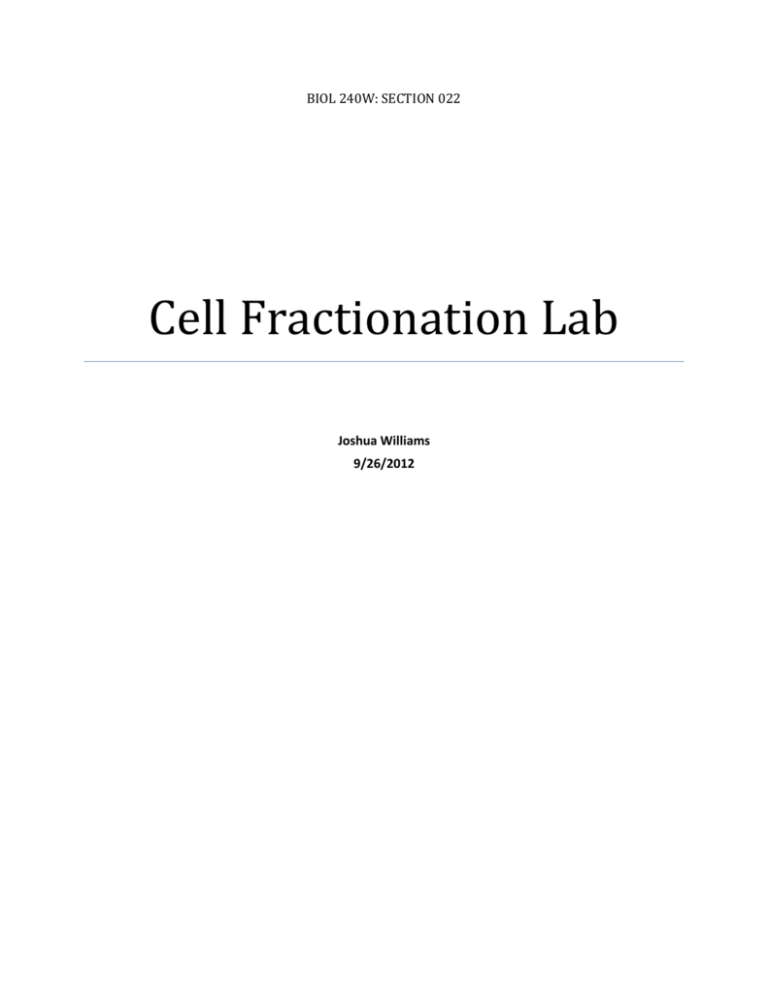
BIOL 240W: SECTION 022 Cell Fractionation Lab Joshua Williams 9/26/2012 Introduction: Standard cell fractionation is a useful tool for splitting cells into their component organelles. By utilizing destruction of the cell membrane and differential centrifugation, a cell can be broken into its substituent parts. The theory behind this is that at slower speeds during centrifugation, heavier organelles will fall out of the solution while at faster speeds lighter organelles will fall out of solution. When done in a stepwise fashion the resulting pellets (solid mass that fell out of solution) should be composed entirely of similar organelles. The question is whether this method will be effective enough to separate chloroplasts, amyloplasts and nuclei during different centrifugations. The densities of these three organelles are as follows; 1.6-1.63g/cm-3 for amyloplasts, 1.32g/cm-3 for Nuclei, and 1.211.24g/cm-3 (Hinchmann, 74) for chloroplasts. In other words, going off of density, amyloplasts should be expected to fall out of solution first, nuclei second, and chloroplasts third. In this experiment, the homogenate is centrifuged three times. Therefore in order for cell fractionation to be effective and for the desired result of separate organelles to be observed; amyloplasts must form the pellet after the first centrifugation, DNA must form the second, and chloroplasts must form the third. If the pellets are not formed in this fashion then cell fractionation, as it has been set up, is not an effective solution to organelle differentiation. In order to differentiate organelles under a microscope cytochemical testing must be utilized. There are specific dyes that are able to attach or alter components inside the organelles. In an amyloplast there is generally a large amount of starch present, a molecule that gives the organelle much of its weight. In the presence of Iodine, the amylose in starch is altered in such a way that the starch turns a deep blue color. This allows for the easy identification of starch, and therefore amyloplasts, while being observed under a microscope. A similar cytochemical test used is methylene blue. Methylene blue is useful in staining DNA and RNA found within nuclei. When methylene blue is added to a pellet the nuclei are easily recognizable as dark blue orbs. No cytochemical testing is required for chloroplasts as these are naturally bright green due to the presence of chlorophyll. Without these cytochemical tests, observation under the microscope would yield little information, as it would difficult to differentiate between the organelles. I expect the results of this experiment to indicate that cell fractionation is a viable means of separating organelles into groups and will allow for study of these individual organelles. I expect that amyloplasts will be removed at pellet 1, nuclei at pellet 2, and chloroplasts at pellet 3. Methods: We began the experiment by preparing a spinach cell homogenate. [Burpee, 2009]Once this homogenate was prepared we moved onto differential centrifugation. In differential centrifugation the cell homogenate was centrifuged and the resulting pellet and supernatant were separated. The supernatant was then centrifuged again, and the pellet was re-suspended and observed under a microscope. This procedure was repeated 3 times. The first time, the full cell homogenate was centrifuged at 100 g for 10 minutes and 1 ml of CRB was added to the subsequent pellet (P1). The second rotation, the supernatant was centrifuged at 800 g for 10 minutes. The resulting pellet (P2), due to thickness, was suspended in 5 ml of CRB. The third rotation, the supernatant was centrifuged at 10000 g for 10 minutes. The resulting pellet (P3) had 5 ml of CRB added to it. The final supernatant was not centrifuged, labeled as S3, and treated as a suspended pellet for the next step. The next step, cytochemical microscopic analysis, involved the dyes methyl blue and iodine. Methyl blue was used to differentiate DNA and nuclear components, and iodine was used to differentiate starch components (amyloplasts). Because of their naturally green appearance, chloroplasts require no dye to differentiate. Three samples of each of the three pellets and the S3 supernatant were put onto individual microscope slides, for a total of 12 slides. One of the samples was stained with nothing, one with methyl blue, and one with iodine. Each was observed under a compound light microscope until individual structures could be determined. Magnifications for all samples were not the same. The next step was determining the relative abundance of organelles in each of the samples. Instead of counting we devised a rating system based arbitrarily on the highest concentration of . For example the highest concentration observed was chloroplasts in P2. we assigned a nine to this sample and, relative to that, determined the abundance of organelles for the other 11 samples. Results: Plant Cell Type Abundance of Organelles Observed Pea Methylene Blue Iodine Unstained Pellet 1 6 9 8 Pellet2 4 4 4 Pellet 3 1.5 1 1.5 Supernatant 3 0 0 0 Relative concentrations of organelles in pea differential centrifugation Plant Cell Type Abundance of Organelles Observed Spinach Methylene Blue Iodine Unstained Pellet 1 6 2.5 4 Pellet 2 5 0 9 Pellet 3 1 0 1 Supernatant-3 0 0 0 Relative concentration of organelles in spinach differential centrifugation Relative Abundance of Organelles in Spinach 10 9 8 7 6 Methylene Blue 5 Iodine 4 Unstained 3 2 1 0 Pellet 1 Pellet 2 Pellet 3 S3 Relative Abundance of Organelles in Peas 10 9 8 7 6 Methylene Blue 5 Iodine 4 Unstained 3 2 1 0 Pellet 1 Pellet 2 Pellet 3 S3 The charts indicate that amyloplasts were removed in pellet 1 for spinach. For peas, the majority of amyloplasts were removed in pellet 1 and some in pellet 2. The results also indicate that nuclei and chloroplasts were removed from the supernatant at similar times and at similar concentrations for both peas and spinach. For all three organelles, there was virtually no presence in supernatant three. For nuclei and chloroplasts, there was a very small concentration of organelles in pellet 3 for both spinach and peas. For peas in general, there was little to no visible separation of organelles for different centrifugations. Discussion: Based on the available data it has been found that cell fractionation is not a viable means of creating any appreciable separation of these specific organelles. In peas, it was found that relative abundance was similar across all three organelles. In spinach the similarity of DNA and chloroplast results indicate no difference as well. By using cytochemical analysis specific structures being looked for were easily identifiable and this increased the accuracy of the data tremendously. I do find the results to be illogical so as to be inaccurate. I would recommend a follow up experiment to be conducted with a few changes and improvements to keep in mind. For one, the system of counting and determining relative abundance should be more objective and less arbitrary. Second, a standardized addition of CRB re-suspension agent, instead of the different additions we used, should be utilized. Finally, the speeds at which the three centrifugations occur should be checked and fixed for future experiments so that the difference in weight can be enhanced. I also hypothesize that because amyloplasts and chloroplasts can transform into one another Gillot et al. (1991) that another way to create large concentrations of these specific organelles is possible. By using the right set of conditions so that most chloroplasts are converted to amyloplasts, differential centrifugation would give you a high enough concentration of amyloplasts in the first pellet to be of some use. By the same token, if most are converted to chloroplasts, then there should be enough chloroplasts in the third pallet to also be used. By cultivating these two populations, large concentrations of these organelles can be harvested. References: Gillott, M.A., Erdos, G., and Buetow, D.E., 1991. Light-induced chloroplast differeentiation in soybean cells in suspesnion culture; Untrastructural changes during the bleaching and greening cycles. Plant Physiology, 96, 962 Hinchman, R.R. & Gordon, S. A. 1974. Amyloplast size and number in gravity- compensated oat seedlings. Plant Physiology, 53, 398
